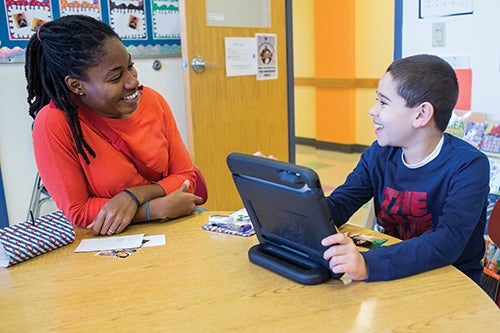Handheld technology has stumped parents in this modern era. They rely upon it to pacify their children when convenient, but also lament its constant presence and struggle to set limits so that kids are playing tag as well as watching music videos on YouTube.
Many parents can’t live with tablets, iPhones and the like, or without them. But a subset of parents wouldn’t be able to communicate with their children, or would have much more trouble doing so, if it weren’t for these relatively new devices.
As the rate of autism spectrum disorder diagnosis has increased markedly over the last decade, so too has the emphasis on helping children with autism communicate to their full potential. Kari Dunlop, clinical director at The Darnell School in Hudson, has seen how technology has aided this quest.
Then and now
With 20 years of experience in the field of special education, Dunlop remembers when clunkier speech generation devices made by manufacturer DynaVox were the tools du jour for students on the autism spectrum who couldn’t speak well enough to communicate their wants and needs. They looked like an iPad, Dunlop said, but thicker and heavier, and much more expensive. Students needed insurance coverage to get them and if they broke, repairs would often take a long time. They were also generally used only by students who couldn’t speak at all.
But the evolution of tablet technology led by Apple Inc. has changed the dynamics in today’s classrooms.
The Darnell School, owned by human services nonprofit HMEA Inc., has incorporate tablets in the classroom, where teachers use Applied Behavior Analysis to help students develop skills, including communication. iPads are owned by the school and assigned to the students to use throughout the day. A handful of apps are used to help students communicate. Proloquo2Go, which Dunlop calls “the Cadillac” of communication apps, is used most often but there are a handful of others that teachers and students find helpful.
By selecting icons from a screen, Proloquo2Go helps students build sentences conveying their ideas or wants. The app uses a voice output, and some students are able to use the output as a model so that they can actually practice speaking themselves, said Dunlop.
“It helps them expand their sentence length or use more complex sentences, or speak to someone who they might be nervous to speak to,” Dunlop said.
Known for their user friendliness, the iPads are easily mastered and Dunlop said students enjoy using them. Teachers use subject matter that interests students to their advantage, as a way to engage students who have trouble connecting.
While students don’t bring their classroom iPads home, many also have their own devices, Dunlop said. Some families pay out-of-pocket for the devices but in Massachusetts, there is usually insurance coverage for tablets that help autistic children communicate, and there are nonprofit organizations that provide grants for the devices, Dunlop noted.
Portability
Another advantage of tablets and other handheld devices is that they’re commonly used in public and they’re easy to take along. Cary Stephens’ 12-year-old son Ryan, a student at The Darnell School, carries an iPhone with him, using pictures on the touch screen to communicate.
Ryan was diagnosed with autism spectrum disorder when he was 2 years old. Ryan can speak and understands much of what is is said to him but has trouble communicating his thoughts. He has few interests, but technology is a big exception. Stephens was struck when Ryan, at the age of 3, was able to use a computer mouse well and his aptitude for technology has continued as computers have evolved.
Because most of the language he has learned has sprung from technology, Stephens and her husband view it as an integral part of Ryan’s daily life.
Still, technology isn’t perfect. Stephens said the Proloquo2Go app, for instance, is somewhat confusing to Ryan. For instance, he doesn’t understand that if he asks for pizza in the middle of the school day, he probably won’t get it. Stephens hopes apps will become even more sophisticated in order to avoid scenarios like this one.
“I would love it if we could just give it to him and he could communicate all the things he thinks and feels,” Stephens said.
Old-fashioned teaching
The communication app market is ever changing. So says Beth Bellone, director of Speech & Language Services at the New England Center for Children, a world-renowned autism education center headquartered in Southborough. Bellone said she spends one day every week sifting through new apps and reviews to determine what the latest options are. Apps are carefully considered and tested before purchases are made.
“You have to find your trusted source (of information) because it’s easy to get caught up in whatever is the newest and most trendy thing,” Bellone said. She added apps are just one tool that speech language pathologists use, albeit an important one.
“We need to continue with good, old-fashioned interaction and teaching,” Bellone said.
Go with what works
Because children with autism vary widely in their abilities and needs, there shouldn’t be a one-size-fits-all approach to the use of technology to aid communication, said Kara Medeiros, a professor in the communication sciences and disorders department at Worcester State University.
A speech language pathologist by training, Medeiros researched augmentative and alternative communication methods for use in aiding verbal development. This means using all forms of communication, such as pictures, symbols and gestures, to help children communicate. Medeiros said technology has now caught up with these methods.
“The biggest thing is, use what works. If it works and it’s successful, then it’s golden,” Medeiros said.

